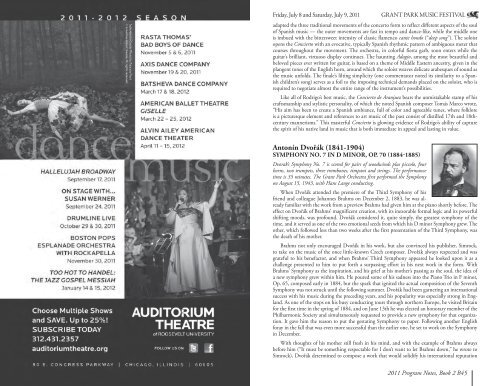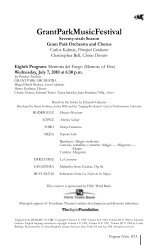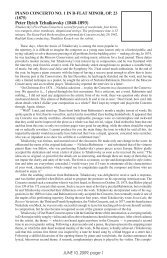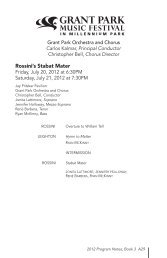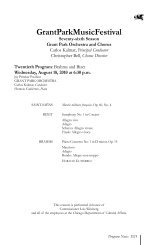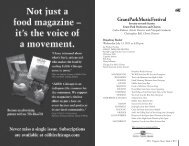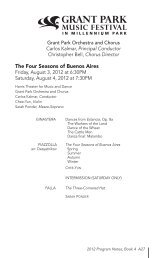2011 Program Book 2 - Spanish Guitar - July 8 & 9.pdf
2011 Program Book 2 - Spanish Guitar - July 8 & 9.pdf
2011 Program Book 2 - Spanish Guitar - July 8 & 9.pdf
You also want an ePaper? Increase the reach of your titles
YUMPU automatically turns print PDFs into web optimized ePapers that Google loves.
Friday, <strong>July</strong> 8 and Saturday, <strong>July</strong> 9, <strong>2011</strong><br />
GRANT PARK MUSIC FESTIVAL<br />
adapted the three traditional movements of the concerto form to reflect different aspects of the soul<br />
of <strong>Spanish</strong> music — the outer movements are fast in tempo and dance-like, while the middle one<br />
is imbued with the bittersweet intensity of classic flamenco cante hondo (“deep song”). The soloist<br />
opens the Concierto with an evocative, typically <strong>Spanish</strong> rhythmic pattern of ambiguous meter that<br />
courses throughout the movement. The orchestra, in colorful fiesta garb, soon enters while the<br />
guitar’s brilliant, virtuoso display continues. The haunting Adagio, among the most beautiful and<br />
beloved pieces ever written for guitar, is based on a theme of Middle Eastern ancestry, given in the<br />
plangent tones of the English horn, around which the soloist weaves delicate arabesques of sound as<br />
the music unfolds. The finale’s lilting simplicity (one commentator noted its similarity to a <strong>Spanish</strong><br />
children’s song) serves as a foil to the imposing technical demands placed on the soloist, who is<br />
required to negotiate almost the entire range of the instrument’s possibilities.<br />
Like all of Rodrigo’s best music, the Concierto de Aranjuez bears the unmistakable stamp of his<br />
craftsmanship and stylistic personality, of which the noted <strong>Spanish</strong> composer Tomás Marco wrote,<br />
“His aim has been to create a <strong>Spanish</strong> ambiance, full of color and agreeable tunes, where folklore<br />
is a picturesque element and references to art music of the past consist of distilled 17th and 18thcentury<br />
mannerisms.” This masterful Concierto is glowing evidence of Rodrigo’s ability of capture<br />
the spirit of his native land in music that is both immediate in appeal and lasting in value.<br />
Antonín Dvořák (1841-1904)<br />
SyMPHONy NO. 7 IN D MINOR, OP. 70 (1884-1885)<br />
Dvorak’s Symphony No. 7 is scored for pairs of woodwinds plus piccolo, four<br />
horns, two trumpets, three trombones, timpani and strings. The performance<br />
time is 35 minutes. The Grant Park Orchestra first performed the Symphony<br />
on August 15, 1943, with Hans Lange conducting.<br />
When Dvořák attended the premiere of the Third Symphony of his<br />
friend and colleague Johannes Brahms on December 2, 1883, he was already<br />
familiar with the work from a preview Brahms had given him at the piano shortly before. The<br />
effect on Dvořák of Brahms’ magnificent creation, with its inexorable formal logic and its powerful<br />
shifting moods, was profound. Dvořák considered it, quite simply, the greatest symphony of the<br />
time, and it served as one of the two emotional seeds from which his D minor Symphony grew. The<br />
other, which followed less than two weeks after the first presentation of the Third Symphony, was<br />
the death of his mother.<br />
Brahms not only encouraged Dvořák in his work, but also convinced his publisher, Simrock,<br />
to take on the music of the once little-known Czech composer. Dvořák always respected and was<br />
grateful to his benefactor, and when Brahms’ Third Symphony appeared he looked upon it as a<br />
challenge presented to him to put forth a surpassing effort in his next work in the form. With<br />
Brahms’ Symphony as the inspiration, and his grief at his mother’s passing as the soul, the idea of<br />
a new symphony grew within him. He poured some of his sadness into the Piano Trio in F minor,<br />
Op. 65, composed early in 1884, but the spark that ignited the actual composition of the Seventh<br />
Symphony was not struck until the following summer. Dvořák had been garnering an international<br />
success with his music during the preceding years, and his popularity was especially strong in England.<br />
As one of the stops on his busy conducting tours through northern Europe, he visited Britain<br />
for the first time in the spring of 1884, and on June 13th he was elected an honorary member of the<br />
Philharmonic Society and simultaneously requested to provide a new symphony for that organization.<br />
It gave him the reason to put the gestating Symphony to paper. Following another English<br />
foray in the fall that was even more successful than the earlier one, he set to work on the Symphony<br />
in December.<br />
With thoughts of his mother still fresh in his mind, and with the example of Brahms always<br />
before him (“It must be something respectable for I don’t want to let Brahms down,” he wrote to<br />
Simrock), Dvořák determined to compose a work that would solidify his international reputation<br />
B44 <strong>2011</strong> <strong>Program</strong> Notes, <strong>Book</strong> 2<br />
<strong>2011</strong> <strong>Program</strong> Notes, <strong>Book</strong> 2 B45


